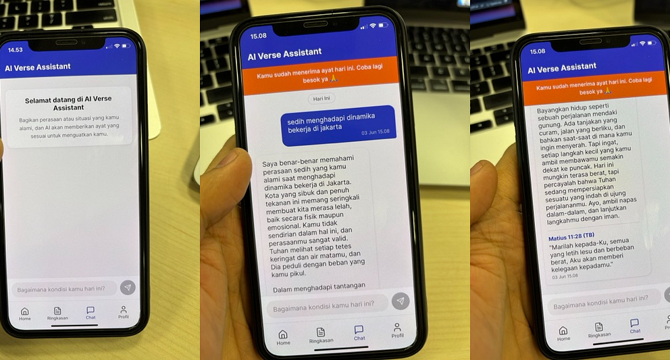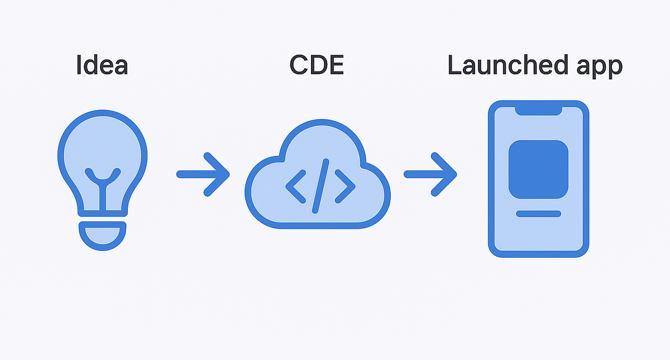Product Management News
Medium
372

Image Credit: Medium
The Foundational Work Behind AI Success Most Teams Skip
- To achieve AI success, focus on understanding users' business and workflows deeply.
- Best AI features are born from a profound insight into user experience.
- Start with understanding user operations before AI capabilities to ensure value and feasibility.
- The User-First AI Framework emphasizes understanding user workflows for SaaS products.
- Identify opportunities for improvement in each step of the user workflow.
- Use subjective quality bar hypotheses to gauge potential improvements.
- Iterate through building, testing, and learning to refine AI solutions with real users.
- Ensure user adoption through systematic evaluation and testing.
- Collaborate closely with model developers to align on user value and technical feasibility.
- Focus on delivering user value consistently and scale up with systematic evaluation.
Read Full Article
22 Likes
Link In Bio
327

Image Credit: Link In Bio
The software 40% of social marketers use
- Part two of the Very Online Survey results has been published.
- 40% of respondents are using specific social software.
- Unique social KPIs are recommended for tracking.
- Insights on why 64% of social marketers still publish directly on platforms, the pressure to adopt AI, missing tech stack elements, tools for finding influencers, and more are covered in the report.
Read Full Article
17 Likes
Medium
377

Image Credit: Medium
The ultimate guide to understanding and managing technical debt in agile teams
- Technical debt, if managed early and deliberately, can be a strategic asset for agile teams, accelerating delivery and supporting learning.
- Understanding different forms, causes, and management of technical debt is crucial for agile teams, tech leads, and product managers.
- Technical debt, like financial debt, accumulates 'interest' over time in the form of increased complexity and maintenance costs.
- Identifying types of technical debt helps teams evaluate risks and manage it effectively as a normal part of software development.
- Agile methodologies can lead to the accumulation of technical debt due to the emphasis on rapid delivery and responsiveness.
- Agile frameworks like Scrum and Kanban provide tools to proactively recognize and address technical debt.
- Recognizing early signs of technical debt accumulation is essential to prevent it from becoming a major impediment.
- Prioritizing technical debt strategically based on factors like impact and cost is important for effective management.
- Maintaining a technical debt register and using prioritization frameworks can aid in clear communication and decision-making.
- Strategies like regular refactoring and embedding debt reduction into development processes can help manage and reduce technical debt over time.
Read Full Article
22 Likes
Medium
408

Image Credit: Medium
Why the Product Manager Role is Essential, and Will Never Vanish
- Product management is not obsolete and plays a unique and irreplaceable role in balancing conflicting forces within organizations.
- Product managers are essential for engineering seamless user experiences that resonate, inspire, and connect on a deeper emotional level.
- The product team, led by the product manager, prioritizes caring for the user's long-term relationship and experience over short-term targets.
- Product managers raise alarms, care about customer journeys, user satisfaction, and long-term retention, focusing on aspects beyond mere numbers.
Read Full Article
24 Likes
Discover more
- Programming News
- Software News
- Web Design
- Devops News
- Open Source News
- Databases
- Cloud News
- Operating Systems News
- Agile Methodology News
- Computer Engineering
- Startup News
- Cryptocurrency News
- Technology News
- Blockchain News
- Data Science News
- AR News
- Apple News
- Cyber Security News
- Leadership News
- Gaming News
- Automobiles News
Medium
158

Image Credit: Medium
Stop! Before you add another feature, ask this one question.
- Shifting into a Value Builder mindset involves asking why the product is being built, leading to a shared understanding of value across the organization.
- Implementing the Value Builder mindset helped a company focus on solving real customer pain points and aligning on measurable business impacts.
- Through hard discussions and prioritization, the organization defined value in decisions and actions, improving focus and clarity.
- The Value Builder approach required teams to explain the customer pain they were addressing, the expected business impact, and the importance of each initiative.
- Regular cross-functional Value Reviews were conducted to ensure alignment on value definitions and objectives across product, engineering, marketing, and sales.
- A structured system, including a 4-Point Initiative Checklist and a 2x2 Matrix, was established to evaluate initiatives based on customer pain, business impact, confidence level, and risks.
- This mindset shift led to improved decision-making, ownership, accountability, and autonomy within the teams, resulting in more meaningful outcomes.
- Prioritizing value over features not only enhanced product development but also fostered partnerships with customers and increased retention and expansion.
- By institutionalizing the Value Builder mindset through rituals, systems, and expectations, the company achieved intentional growth and reduced wastage of time and energy.
- The focus on creating value rather than just increasing velocity led to a more intentional, impactful, and sustainable approach to product development.
- In conclusion, emphasizing value as the combination of customer pain and business gain, backed by evidence, facilitates scalable and purposeful growth.
Read Full Article
9 Likes
Medium
245
Image Credit: Medium
Why Self-Service BI Fails (and How AI-Powered Analytics Is Fixing It)
- Despite the promise of self-service BI tools to empower users, many platforms fail to account for varied data fluency, trust issues, and fragmented tooling, leading to underuse and abandonment.
- Users often feel overwhelmed by complex steps required to create reports, resulting in low confidence in interpreting data without assistance from data teams.
- Discrepancies in metrics and definitions lead to a lack of trust in BI tools, with only 3% of employees trusting their company's data, highlighting the pervasive issue.
- AI-powered analytics is transforming the self-service BI landscape by enabling Natural Language Processing (NLP) for easier data querying and providing proactive insights to enhance decision-making.
- Anomaly detection and automated governance through AI help ensure consistency, accuracy, and compliance, addressing governance challenges in self-service BI.
- Moving towards AI-assisted decision intelligence shifts the focus from 'DIY BI' to active collaborations between tools and users, enhancing the data consumption and decision-making process.
- Organizations embracing AI-powered BI must set clear, measurable outcomes, invest in data literacy training, address data quality issues, and foster collaboration to maximize the benefits.
- AI-enhanced BI tools can help organizations make faster decisions, with a 5x greater likelihood of speeding up decision-making than competitors, leading to measurable gains in revenue and operational efficiency.
- While technology plays a vital role, building a strong BI culture and combining AI advancements with human expertise is crucial for successful self-service BI implementation.
- The future of business intelligence lies in leveraging AI to bridge gaps, enhance data-driven decisions, and streamline processes for faster, smarter insights and actions.
- In conclusion, the integration of AI into self-service BI is reshaping the way organizations interact with data, offering a path to more informed, efficient, and successful decision-making in the modern business landscape.
Read Full Article
14 Likes
Medium
236

Image Credit: Medium
Post 4 PMPrep :Design a Product for X: What Actually Works When You’re Put on the Spot
- During a Google PM interview, the candidate struggled with designing a web search engine for children under 14.
- The candidate initially mentioned generic solutions like content filters and parental controls, indicating panic.
- The interviewer was looking for the candidate's ability to break down complex problems systematically rather than testing knowledge of children.
- The candidate eventually learned a simple, repeatable process for tackling design questions effectively.
Read Full Article
14 Likes
Logrocket
381

Image Credit: Logrocket
Why switching to weekly research sprints was a game-changer
- As the AI revolution progressed, there were debates within a product team about the effectiveness of continuous discovery and allocating resources to research projects.
- To address their needs for quick learning and staying ahead, the team transitioned to weekly research sprints, finding them to be a significant improvement.
- In the fast-paced AI-driven product landscape, the company struggled to keep up with the demands for learning and adapting to new segments.
- While continuous interviews and research projects were helpful, they fell short of meeting the team's requirements for rapid insights.
- The shift to weekly research sprints allowed the team to conduct multiple interviews each week, leading to accelerated learning and decision-making.
- The structured process involved defining research questions, conducting interviews and surveys, synthesizing insights, and planning based on findings within a week.
- Although the process posed recruitment and capacity challenges, partnering with external agencies and freelance researchers helped overcome these hurdles.
- Despite the higher costs associated with weekly sprints, the efficiency and depth of insights gained justified the investment for the team.
- The approach of rapid research and immediate action based on insights worked well for the team operating in a dynamic environment.
- Recommendations include starting with continuous interviewing and gradually scaling up research efforts, but for fast-paced environments, weekly research sprints can offer significant benefits.
Read Full Article
22 Likes
Medium
240

Image Credit: Medium
Cracking the Candy Code
- Candy Crush Saga, launched in 2012, has become a global phenomenon in the casual gaming industry, with over 3 billion installations and generating significant annual revenue.
- Challenges faced by Candy Crush include early-level churn and retention plateau, leading to initiatives in personalized onboarding, social features, and contextual monetization strategies to address player engagement and revenue growth.
- Three key experiments were conducted by Candy Crush, including Candy Coach Onboarding, Candy Squad social feature, and Boost Vault + Personalization to optimize player experience and engagement, with variant C showing the highest uplift in key metrics.
- King, the studio behind Candy Crush, implemented AI-powered level difficulty adjustment, Boost Vault mechanics, Candy Squad community engagement, and improved character-led onboarding based on successful experiments, showcasing the game's evolution through data-driven innovation and player-centric design.
Read Full Article
14 Likes
Medium
99

Image Credit: Medium
Bible App, Part 2: n8n, AI Agents, and the Road from Prototype to Real App — as a PM Who Can’t Code
- The journey of building a Bible AI app continues in this diary entry, focusing on real automations, integrating n8n, and fixing checklist logic.
- Key highlights include scraping liturgical readings, using ChatGPT for daily summaries, and setting up n8n workflows for the app.
- Challenges faced involved redesigning the checklist, dealing with automation tool surprises, authentication issues, and data fitting problems.
- Lessons learned emphasize the importance of tool compatibility and thorough connections over complex code, along with the need for continuous improvement in the development process.
Read Full Article
6 Likes
Medium
0

Ballon d'Or 2025: A New Era Begins — Salah, Dembélé & Yamal Battle for the Crown
- With the Ballon d'Or ceremony approaching in Paris, the world awaits the crowning of a new champion with great anticipation.
- Mohamed Salah has had an outstanding season with 25 goals, 17 assists, and leading Liverpool to a Premier League title, making a strong case for becoming Egypt's first Ballon d'Or winner.
- Ousmane Dembélé, once seen as a wasted talent, has transformed into PSG's top performer with 33 goals, helping the team secure a historic quadruple and potentially earning him the prestigious individual accolade.
- Lamine Yamal, a 17-year-old prodigy from Barcelona, has shown exceptional skills on the field, winning a treble and drawing comparisons to legends like Messi and Iniesta, potentially becoming the youngest Ballon d'Or winner in history.
Read Full Article
Like
Medium
322

Image Credit: Medium
Should a Product Manager Know How to Code?
- Product Managers don't need to be coding experts but having technical awareness can make a significant difference in decision-making.
- In the modern product world, understanding technical concepts can lead to more agile decision-making and help in prioritization.
- PMs need to understand technologies like AI and cloud architecture to contribute meaningfully to discussions and not just act as a mediator.
- Empathy, understanding user needs, and aligning business priorities are foundational for a PM, while technical understanding remains a valuable asset.
Read Full Article
19 Likes
Medium
390

Image Credit: Medium
From Idea to App in Days: Exploring Cloud Development as a Non-Coder
- The writer attended a course on 'AI for Product Growth' which inspired them about the possibilities at the intersection of AI and product development, particularly cloud development environments.
- An article from Making Product Sense by Jacob about fast SaaS and using different CDEs motivated the writer to start building a personal portfolio.
- Initially, struggling with no-code tools, the writer found success using Replit for database management and other essentials, transitioning from idea to execution within a few days.
- The writer's experience with CDEs like Replit has led them to explore using such tools more regularly for personal and work projects, highlighting the ability to quickly bring ideas to life without a technical background.
Read Full Article
23 Likes
Medium
49

Image Credit: Medium
Are You Really Building Great Products?
- The blog discusses the complete product development lifecycle from shaping a vision to delivering a working product.
- Key product management concepts like initiatives, releases, epics, sprints, user stories, acceptance criteria, and road mapping techniques are explored.
- Product managers start by identifying a real user need or problem before validating it through research.
- Articulating goals based on the vision and translating them into metric-based outcomes for success is crucial in product management.
- Initiatives are specific high-level actions that drive toward the overall goal, while releases mark points in time for delivering new features or improvements.
- Roadmaps play a vital role in communicating the product's future and aligning cross-functional teams by outlining what will be built and when to expect it.
- Roadmaps are not crystal balls and should be flexible to adapt to unexpected challenges or changes in the market.
- Organizing roadmaps into priority buckets helps in managing uncertainty and communicating priorities without strict deadlines.
- Product managers should focus on a structured yet flexible approach, keeping user needs at the core to develop impactful products.
- The product development journey involves challenges, victories, and resilience, ultimately leading to the creation of products that make an impact.
Read Full Article
3 Likes
Medium
431

Image Credit: Medium
UX is Becoming Everyone’s Skill: Why That’s Both Powerful and Risky
- User Experience (UX) responsibilities are spreading across functions beyond just designers, thanks to AI tools, low-code platforms, and agile teams.
- Cross-functional UX skills are on the rise, with tools like Figma's AI features enabling collaboration among multiple roles for faster turnaround and more user-centric thinking.
- While a blended approach to UX works well for lean teams or quick idea testing, relying too much on shared ownership can lead to surface-level solutions, inconsistent patterns, and missed opportunities for better user experiences.
- In complex domains, dedicated UX professionals are still crucial for deep dives into user needs, research-backed decisions, and iterative testing to ensure quality and user satisfaction.
Read Full Article
25 Likes
For uninterrupted reading, download the app